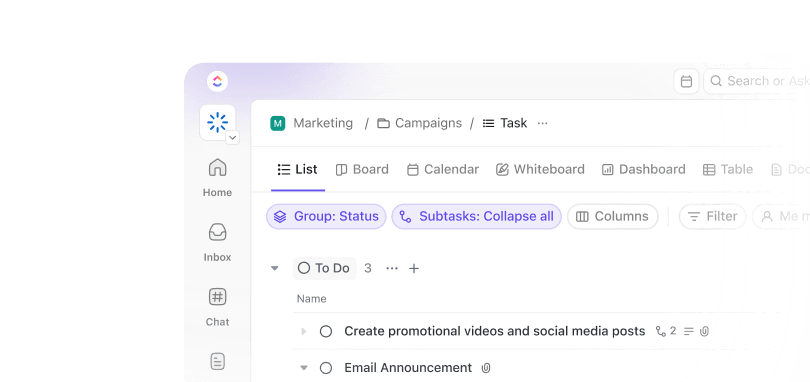It’s one week to launch. Your inbox is on fire, the team chat is chaos, and your calendar looks like abstract art.
Marketing is still waiting on the final copy.
Sales has no idea what’s coming.
Developers are overloaded with ‘just one more tweak.’
Every meeting ends with more questions than answers.
The problem isn’t your team’s skills—it’s the lack of a clear launch calendar. Without one, teams operate in silos, and decisions stall. Instead of a smooth launch, you’re stuck putting out fires.
A launch calendar brings structure, showing what needs to happen, when, and by whom. It aligns teams, surfaces bottlenecks early, and gives you room to adapt when plans shift.
This guide will show you how to build a product launch calendar that turns launch day from panic mode into execution mode.
How to Create a Product Launch Calendar: Templates & Best Practices
What Is a Product Launch Calendar?
A Product Launch Calendar is a centralized timeline that helps teams plan, coordinate, and execute all the moving parts of a product launch. It helps you keep track of tasks, deadlines, and who’s doing what so your entire team can work efficiently and avoid mix-ups.
While the format can vary—a classic Calendar View, a Gantt chart, or a Kanban board with dates—the purpose remains the same: to keep your launch process organized and on schedule.

Why do you need a product launch calendar?
You could manage your launch with a to-do list. But it won’t give you the clarity or control a dedicated launch calendar does.
Here’s why:
- Holistic visibility: A product launch calendar gives you full visibility into tasks, deadlines, and dependencies. This helps you spot conflicts early and keep every team in the loop
- Better organization and less stress: Product launches organize everything, like marketing campaigns, product development, sales training, support prep, and customer feedback—all running simultaneously. This means no more dependence on memory or sticky notes
- Clarified roles and accountability: When every task is listed with an owner and due date, there’s no ambiguity about who’s responsible for what
- Timing is everything: A launch calendar helps you plan around key dates, avoid clashes with competitors or holidays, and build enough pre-launch momentum
- Coordination across teams: A product launch calendar keeps all teams aligned. This allows marketing to plan around feature releases, sales to stay in sync with campaigns, and support to prepare for user questions
Key benefits of a well-structured launch plan
A structured product launch plan is a critical part of your product marketing strategy.
Here’s what it gets you:
- Stronger first impressions = better user adoption: When your launch is streamlined (with clear messaging, polished assets, and no hiccups), users are more likely to trust the product and start using it right away
- No missed marketing windows: A launch plan ensures you don’t forget key promo opportunities like scheduling a Product Hunt launch, syncing with a big industry event, or lining up your influencer outreach on time
- Clear data for future improvements: After launch, you get a detailed timeline of what happened, when, and by whom. This helps you fine-tune your upcoming launches based on real results
- Builds team and stakeholder confidence: A well-structured calendar is an instant confidence booster that shows your team and leadership that every detail is covered
💡 Pro Tip: Consider a rollout with invite-only access, waitlists, or beta testing groups to build anticipation. Limited availability can generate more excitement than an immediate full release.
Essential Components of a Product Launch Calendar
To build a launch calendar that keeps everything on track, here are the essential components you’ll want to include:
- 🎯 Launch goals: Define the outcomes you’re targeting, like signups, product adoption, revenue, or user growth. This makes sure every task aligns with what success actually looks like
- 📅 Launch phases: A solid launch usually happens in three parts: pre-launch (planning, prep, buzz-building), launch (go-live day or week), and post-launch (follow-up marketing strategies, feedback collection, analysis)
- ✅ Tasks and deliverables: A list of all actions and outputs tied to the launch, complete with owners and assignees. Often, teams start with a brain-dump product launch checklist, then plug each task into the calendar with due dates to keep things moving
- ⏳ Deadlines and milestones: Milestones are key progress checkpoints, whereas deadlines are due dates for specific tasks. Together, they structure the timeline and reduce the risk of delays
- 👤 Roles and responsibilities: Each task needs a clear owner. This makes accountability clear and helps distribute work evenly across the team
- 📢 Communication plan: The approach to sharing updates, such as launch briefs and release notes—internally and externally
- 🧰 Resources and assets: The materials required for the launch, like designs, videos, docs, and web pages
Steps to Create a Product Launch Calendar
Now that we know the what and why, let’s learn how to build a successful product launch calendar that keeps your team on the same page:
Step 1: Define goals and target audience
First, you need a clear foundation that starts with two things:
1. Set clear goals
Ask your team: What does success look like for this launch? The more specific the answer, the easier it is to stay focused and measure progress. Plus, these goals act as your North Star—every task on your calendar should tie back to at least one of them.
For example:
- Sales/Revenue: $100k in sales within the first month
- User adoption: 10,000 new sign-ups in the first week
- Market growth: Enter three new industries in Q1
- Engagement: 20% of existing users adopt the new feature in 30 days
- PR/Brand: 15 media mentions or ‘position brand as a category leader’
2. Define your target audience
The better you know your audience, the easier it is to plan the tasks, messaging tone, and marketing channels. Clarify if you’re targeting:
- Existing customers (to upsell or engage)
- New users in a certain segment (age, region, role, industry)
- Early adopters or tech enthusiasts
- A niche vertical or community
💡 Pro Tip: Reverse-engineer your goals. Work backward from your desired outcome to identify the metrics and milestones that actually matter. For instance, if you need 10,000 sign-ups, determine the number of site visitors and the conversion rate needed to achieve that number.
Step 2: Map out key launch phases
A product launch is a multi-step process. Start by setting your launch date or window. If it’s fixed (e.g., a conference or seasonal event), lock it in. If flexible, pick a date that avoids holidays, gives enough prep time, and doesn’t overlap with major industry events.
Here’s what a typical product launch journey looks like:
| Phase | Timeline | Goals | Sample activities | Key stakeholders |
| Pre-launch stage | 4–8 weeks before launch | Build momentum, finalize assets, and start testing | – Design landing pages – Create marketing content (blogs, emails, videos) – Finalize product features – Begin internal testing – Set up analytics and CRM |
Designers, Developers, Product Marketing, QA, Content Team |
| Launch day/week | 0–2 days around launch | Go live, announce, and monitor | Gather feedback, fix issues, and optimize | Everyone: Dev, Marketing, PMs, Support |
| Post-launch stage | 1–4 weeks after launch | Gather feedback, fix issues, optimize | – Analyze metrics – Collect and prioritize user feedback – Push quick fixes or improvements – Publish case studies/testimonials – Continue marketing efforts |
PMs, Growth, Dev, Data, CX |
💡 Pro Tip: integrates with tools like Productboard, Intercom, GitHub, Salesforce, and Figma—keeping handoffs smooth between product, marketing, and engineering.
Step 3: Assign roles and responsibilities
Even the best product launch timeline fails if no one knows who’s doing what. Start by listing all the roles involved in the launch process:
- Product Manager(s), Launch Coordinator
- Engineering Lead, Developers, QA
- Product Design/UX
- Marketing Lead, Content Writer, Designer
- PR/Comms, Sales Lead, Customer Success, Support
- Legal, Operations, External Partners
Then, assign one owner per task or milestone in your calendar. For example, if the task is ‘Launch email campaign,’ the marketing lead owns it—even if others are helping.
If others are involved, add them as watchers or secondary assignees.
💡 Pro Tip: For large product launches, use a simple RACI matrix, like this one:
- Responsible: Marketing Manager (does the work)
- Accountable: Product Manager (owns the outcome)
- Consulted: Legal Team (trademark/compliance input)
- Informed: CEO or other stakeholders (kept in the loop)
Additionally, you can use Custom Fields to tag tasks by role—like Product, QA, or Marketing—and filter by team in views like Board or List. This helps you visualize ownership instantly and avoid silos.
And, simply @mention relevant assignees and owners for tasks.
Step 4: Set deadlines and milestones
Now, it’s time to schedule the work and define key checkpoints.
Milestones mark major progress moments, like ‘Code freeze complete,’ ‘Press materials ready,’ or ‘Go for launch.’ These help you track whether you’re on pace, while task deadlines ensure all the pieces come together on time.
A common approach is backward scheduling. Start at launch day and think backward: “What is the latest day this task can happen by to still make the launch?”
📌 Example: Here’s how backward scheduling might look for a June 30 launch:
- June 23: Final deadline for all major tasks (gives you a 1-week buffer before launch)
- Landing page: Finalize by June 27 (leaves time for review and last-minute tweaks)
- Marketing emails: Draft copy by June 25, get approvals by June 26, set up and test in your email platform by June 28, and schedule to send on June 30
- Development work: Code freeze by June 16 and buffer week for bug fixes from June 17 to June 21
- Press outreach: Start pitching 2–3 weeks before launch → Begin by mid-June
This ensures you don’t schedule anything too late. It also clearly surfaces dependencies: “We can’t do Task X because Task Y (that precedes it) would end up after launch if we don’t start now.”
Next, set a due date (or due week) for each task. Ask the owner how much time they need, then plan accordingly.
💡 Some useful tips:
- Schedule high-risk or unpredictable tasks (like third-party integrations) earlier to give room for delays
- Set a fallback plan early—for example, “If the product isn’t stable by [date], delay launch by a week.”
Step 5: Monitor progress and adjust strategy
A launch calendar is a living document that needs regular updates and attention.
To monitor its performance:
1. Track progress in real time
Once execution starts, track what’s done, what’s pending, and any blockers. Establish a regular sync routine to keep everyone aligned:
- A weekly launch meeting (e.g., every Monday morning) to review progress, plan for the week, and flag issues
- Daily stand-ups, if you’re in a crunch period close to launch
- Quick huddles if your team is small or co-located
- For remote teams, a message update or weekly summary email works well
💡 Pro Tip: Paste notes or user feedback into a Doc, then ask Brain to summarize key themes or generate recommendations for the next sprint.
2. Monitor post-launch metrics
After launch, watch the goals you set in Step 1. Some key things to track:
- Daily signups or sales
- System performance (e.g., downtime, bugs)
- User feedback or complaints
- Marketing performance (email opens, press mentions, web traffic)
If anything’s off, adjust your post-launch activities, like issuing a bug fix, pushing extra promotions, or reworking your messaging.
💡 Pro Tip: Use Forms to collect user feedback or internal QA notes directly into your workspace for fast triage and prioritization.
3. Be ready to adjust (Stay agile)
You might hit a critical bug, react to a competitor’s surprise launch, or want to add a new feature based on beta feedback. When that happens:
- Update the calendar right away—shift dates, reassign tasks, add new ones
- Communicate clearly to your team and stakeholders
- Check dependencies—one change might affect other tasks
- Re-evaluate goals if needed, especially if timelines shift significantly
Additionally, you can streamline product feedback collection with custom Forms that feed directly into your launch workflow. Create intake forms for beta tester applications, feature requests, or post-launch feedback to ensure every detail informs your product iterations.
Launching a product is chaotic—tasks coming in from every direction, tight deadlines, and people asking, “Who’s handling this?”
A spreadsheet works at first. But as things get more complex, it gets harder to manage:
- No real-time updates, so changes get missed
- Ownership is unclear
- You’re switching between emails, chats, and sheets
- Tracking progress or spotting delays is difficult
That’s when people turn to for Product Teams. With this, you can easily manage your product launch calendar—schedule release dates, assign ownership, track progress across teams, attach launch assets, and keep every task visible and accountable—all in one workspace.
Here’s how it helps:
1. AI-powered calendar
Unlike standard calendar apps showing dates, the brand new Calendar is an AI-powered solution that integrates your Tasks, Docs, Chats, and meetings in one place. This makes it perfect for handling complex, fast-moving workflows like product launches.
The best part? Whether you’re on Google Calendar, Outlook, Zoom, or Microsoft Teams, syncs everything so you can join meetings, update tasks, and track time without switching apps.
In a nutshell:
🔄 Auto-schedule your priority tasks: If your dev handoff is due Friday, automatically blocks time on Thursday afternoon to review it. And if your 2 PM call runs over, shifts your blocked focus time (like ‘Write a launch blog post’) and rebalances your day.
⏰ Auto time blocking for deep work: Add a task like ‘Review beta feedback’ to your priority list, and suggests the best open time slots to get it done.
📝 Take meeting notes and turn them into tasks: After your product sync, instantly convert action items (like ‘Send final build to QA’) into tasks. It also assigns, schedules, and links them to your Docs.
🔍 Keep everything connected: Instead of hunting through chats, tasks, or docs, just ask AI: “What’s my top priority today?” or “When’s the QA review call?”—and get an instant answer right in the workspace.
📮 Insight: 18% of our survey respondents want to use AI to organize their lives through calendars, tasks, and reminders. Another 15% want AI to handle routine tasks and administrative work.
To do this, an AI needs to be able to: understand the priority levels for each task in a workflow, run the necessary steps to create tasks or adjust tasks, and set up automated workflows.
Most tools have one or two of these steps worked out. However, has helped users consolidate up to 5+ apps using our platform! Experience AI-powered scheduling, where tasks and meetings can be easily allocated to open slots in your calendar based on priority levels. You can also set up custom automation rules via Brain to handle routine tasks. Say goodbye to busy work!
2. Real-time collaboration
When planning a successful launch, tasks need to stay on schedule, updates have to be shared quickly, and everyone needs to know what’s next. ’s real-time collaboration tools make that possible:
- For starters, Docs is your single source of truth for launch briefs, rollout checklists, and campaign messaging—linked directly to tasks, assignees, and deadlines (no more scattered info across files and folders)


- Meanwhile, Chat brings team conversations into the heart of your workspace. Running behind on design? Message the team directly from the task or project view (no app switching, no lost context)


💡 Pro Tip: Use Brain to write your launch brief. Give it a prompt, and it’ll generate a polished first draft in seconds. You can also use it to fine-tune task descriptions, draft customer-facing release notes, or create support docs as your launch progresses.


3. Advanced reporting
To measure the impact of your product launch, you need to track performance against your original goals—whether it’s user sign-ups, campaign engagement, or release stability.


Start by setting launch-specific targets in Goals using measurable targets like:
- 🎯 Marketing: 20% open rate for launch emails, 15 media mentions, 100k landing page views
- 🧑💼 Sales: $100K in pipeline revenue within the first month
- 📈 Product: 95% crash-free user sessions or <10 support tickets post-launch
- 📣 Engagement: 25% of existing users activating the new feature within 2 weeks
Once your goals are set, track them in real time using the Dashboard.
You can create custom reports that pull in data from your launch calendar, tasks, and milestones. For example, you can track:
- Tasks completed vs. pending tasks by phase—design, development, QA, and marketing
- Overdue or at-risk items across the launch timeline
- Team workload and task distribution
- Time spent on specific stages (like QA or content creation)


4. Automations to stay informed
Automations keeps your timeline moving with automated workflows:
| Trigger | Automation action |
| ‘Finalize Build’ task marked ‘Complete’ | Auto-assigns ‘Run QA Tests’ and schedules it on the calendar |
| QA marks the task as ‘Failed’ | Loops the task back to dev, reassigns it, and reschedules the next review |
| QA task marked ‘Complete’ | Creates a task for the content team to ‘Update Release Notes’ and blocks calendar time |
For example, when QA marks a build as ‘Passed,’ an automation can trigger a review task for the content team with the due date auto-assigned based on your launch timeline.
5. Pre-designed templates
If you don’t want to build your product launch calendar from scratch, comes loaded with ready-to-use product launch plan templates that help you plan faster and stay organized.
Getting started, the Product Launch Checklist Template is designed to help you manage the entire launch process—from planning and scheduling to execution and tracking. This ensures that every critical task is completed before launch and reduces the risk of delays or last-minute surprises.
This product marketing template comes with several built-in views:
- Gantt View: Ideal for building your launch timeline and visualizing dependencies
- Milestones View: Highlights your key launch checkpoints, such as ‘Internal Demo,’ ‘Beta Launch,’ or ‘Go Live’
- Timeline View: Offers a high-level look at upcoming tasks and deadlines across the entire launch
- Board View: Transforms your checklist into a kanban-style layout, which is perfect for daily task management
- List View: Gives you a simple, organized way to manage all tasks with details like assignees, due dates, and Custom Fields visible in one place
- Activity View: Provides a real-time feed of recent updates across the launch project
You can also use Gantt chart project templates that help you schedule tasks, set dependencies, and visualize how the pre-launch stage, launch day/week, and post-launch phase fit together.
Best Practices for a Successful Product Launch
Having a plan and the right tools is just the start. Smart execution is what makes a product launch strategy succeed.
Here are the tips that separate a mediocre launch from a great one:
1. Start early and plan thoroughly: Build in more lead time than you think you need—it’s way easier to launch early than to clean up a rushed mess
2. Involve all stakeholders: Get input from engineering, design, QA, sales, support, legal, and marketing teams upfront. It prevents last-minute surprises and builds buy-in
3. Ensure high-quality testing and QA: Build in time for QA, user testing, and performance checks. Run a soft launch or beta to catch issues early—internal tests work too. If major issues pop up, delay the launch
4. Have a solid customer communication plan: Segment your audience (e.g., send a different announcement to existing customers vs. prospects), focus on value over features, and include links to blogs or demos
5. Learn and document lessons: What went well? What didn’t? What should we do differently next time? Jot it all down and update your launch checklist or playbook. Use the lessons now so the next launch runs even smoother
Bring Your Entire Product Launch Strategy Together with
A well-structured product launch calendar keeps everything (and everyone) on track, from setting launch goals and mapping out key phases to assigning tasks and adapting in real time.
gives you all the tools to make that happen in one place.
’s Calendar schedules tasks by priority, blocks focus time, and updates timelines automatically, while Docs, Chat, and Dashboards centralize your launch planning and team collaboration. Further, the product launch templates give you a structured starting point with built-in views like Gantt, Timeline, and Milestones.
Want to build a smarter, more collaborative launch calendar?
Sign up for today! 🙌


Everything you need to stay organized and get work done.














